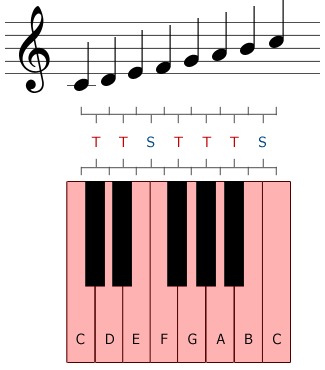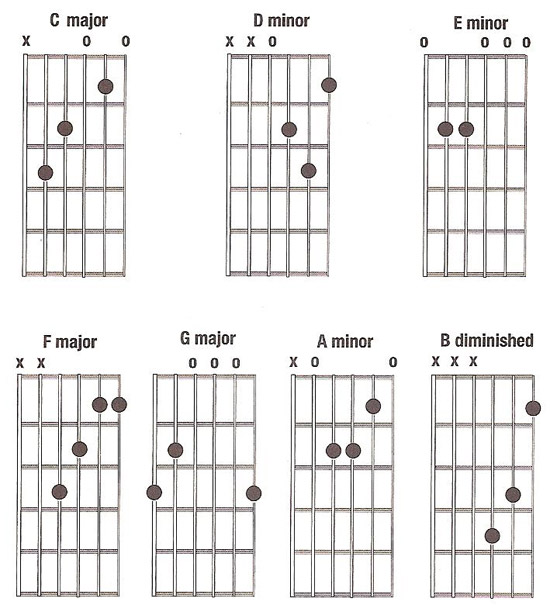major scale

Scale of C major.

Harmonized triads of C major.
A major scale is a diatonic scale having semitones between the third and fourth and the seventh and eighth notes. Every major scale is made up of two halves. For example, in the case of the scale of C major these halves contain the notes C, D, E, and F, and G, A, B, and C. Each half is called a tetrachord and has an interval pattern of tone, tone, semitone. An interval of a tone separates the two tetrachords (F to G).
In C major, the upper tetrachord is G, A, B, C. These notes make up the lower tetrachord of G major. The upper tetrachord of G major (D, E, F♯, G) is the lower tetrachord of D major. This change always happens when one more sharp is added to the new key signature. The rule is: in sharp keys, the upper tetrachord becomes the lower tetrachord of the key with one extra sharp. Therefore, the lowest note of the upper tetrachord of the old key becomes the tonic, or keynote, of our new sharp key.
The seventh note of a major scale is always one semitone below the keynote. In G major, for instance, the keynote is G, the seventh (F♯) is one semitone below G. This seventh note leads the ear to return to the key note and is, therefore, called a leading note.
The order of sharps that emerges is: F♯, C♯, G♯, D♯, A♯, E♯, B♯. In order of increasing number of sharps, the major scales with sharps are:
G major (1 sharp, F♯)
D major (2 sharps, F♯ CF♯)
A major (3 sharps, F♯, C♯, G♯)
E major (4 sharps, F♯, C♯, G♯, D♯)
B major (5 sharps, F♯, C♯, G♯, D♯, A♯)
F♯ major (6 sharps, F♯, C♯, G♯, D♯, A♯,
E♯)
C♯ major (7 sharps, F♯, C♯, G♯, D♯, A♯,
E♯, B♯)
A similar pattern emerges with key signatures that are made up of flats. In C major, the lower tetrachord is C, D, E, F. This is also the upper tetrachord of F major, the key of which has one flat. The lower tetrachord of F major (F, G, A, B♭) if also the upper tetrachord of B♭ major, the key of which has two flats. Therefore, the highest note of the lower tetrachord of the old key becomes the tonic, or key note, of the new flat key.
Just as key signatures with sharps had a pattern, so do those with flats. The difference is that each new flat added is a fourth away from the previous one: B♭, E♭, A♭, D♭, G♭, C♭ F♭.
F major (1 flat, B♭)
B♭ major (2 flats, B♭, E♭)
E♭ major (3 flats, B♭, E♭, A♭)
A♭ major (4 flats, B♭, E♭, A♭, D♭)
D♭ major (5 flats, B♭, E♭, A♭, D♭, G♭)
G♭ major (6 flats, B♭, E♭, A♭, D♭, G♭,
C♭)
C♭ major (7 flats, B♭, E♭, A♭, D♭, G♭,
C♭ F♭)
A clear way to understand these relationships is using the circle of fifths.
| List of all major scales | |||||||
|---|---|---|---|---|---|---|---|
| C major | C | D | E | F | G | A | B |
| D major | D | E | F# | G | A | B | C# |
| E major | E | f# | G# | A | B | C# | D# |
| F major | F | G | A | Bb | C | D | E |
| G major | G | A | B | C | D | E | F# |
| A major | A | B | C# | D | E | F# | G# |
| B major | B | C# | D# | E | F# | G# | A# |
| C# major | C# | D# | E# | F# | G# | A# | B# |
| Eb major | Eb | F | G | Ab | Bb | C | D |
| F# major | F# | G# | A# | B | C# | D# | E# |
| Ab major | Ab | Bb | C | Db | Eb | F | G |
| Bb major | Bb | C | D | Eb | F | G | A |
In solfege, the notes of the major scale are named as follows: Do, Re, Mi, Fa, Sol, La, Ti
Harmonized chords of the major scale
Starting from each note of a major scale, it's possible to construct a harmonized chord by taking the note itself (the root) and adding the third and fifth above it. In the case of C major, we end up with the following series of triads: C major, D minor, E minor, F major, G major, A minor, and B diminished. The diagram to the right shows how these these chords are played on a guitar in open position.


